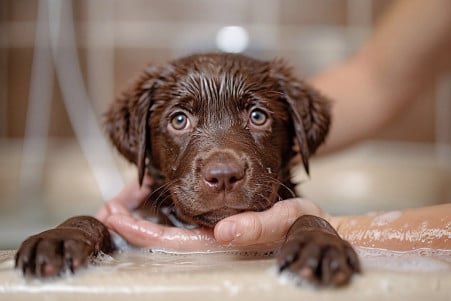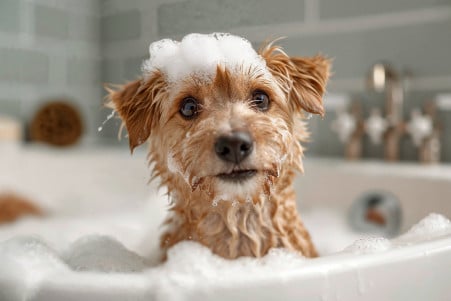When Can You Bathe a Puppy? Ideal Age & Grooming Tips
5 February 2024

If you’ve recently brought a new puppy into your home, you may be wondering when you should give them their first bath. The answer is that you can safely give your puppy their first bath at eight weeks old.
Up until that point, you can use a warm, damp cloth to clean them. It’s important to make sure that you’re using a puppy-formulated shampoo and that you’re not bathing them more than once a month.
Below, we’ll cover insights from veterinary science and animal care professionals. We’ll cover puppy developmental stages, skin and coat health, and psychological responses to grooming. This well-rounded view will give you the information you need to make sure that your puppy’s first bath is safe, timed correctly, and a positive experience for both of you.
When can you bathe a puppy?
When Do They Happen? Puppy Development in the First Eight Weeks
Puppyhood is a time of rapid growth and development, and the first few weeks of a puppy’s life are particularly important in terms of setting the stage for future health and behavior.
According to The Spruce Pets, during the first two weeks of life, puppies’ eyes and ears open, although their vision and hearing won’t be fully developed for a while.
These developments are the first in a series of important milestones that occur during a critical period of development when puppies will first start to interact with their environment, including their mother and littermates and, eventually, the world at large, as the American Kennel Club explains.
The mother’s care during this time is important because it helps puppies grow and learn important social skills through her interactions with them and their littermates. Puppies’ increasing independence can be seen when they learn to walk at three to four weeks of age and begin to play, which is a sign that they’re ready for new experiences, including their first bath.
Between five and eight weeks of age, puppies are weaned from their mother’s milk and begin to eat solid food, which is important for their continued growth and development.
By eight weeks of age, which is when the American Kennel Club says it’s safe to give a puppy its first bath, puppies are ready to start to take on the world and learn to adapt to new experiences, including grooming.
This is an important time in their development, and it will set the stage for the next phase of ensuring that their physical health keeps up with their developmental progress.
The Bottom Line: Cleanliness and Puppy Safety
While cleanliness is next to godliness for many puppy owners, it’s important to be careful about how soon you decide to give your puppy a bath. Technically, as Whole Dog Journal notes, puppies can be bathed at any age if it’s necessary for their health and safety.
However, it’s important to make sure that you can keep them warm and dry after the bath to avoid any potential health problems. This is because a puppy’s skin, like their immune system, is still developing and can be sensitive to potential disruptions.
As a paper from PMC explains, a dog’s diet can have a big impact on the microbiome of their skin, with a raw diet leading to a more diverse microbiome than a kibble-based diet. This is especially important for puppies because the food they eat can directly impact the resilience of their skin and the bacteria that live on it, which can, in turn, impact how they respond to being bathed.
In addition, if a puppy is bathed too early, it can make any potential nutritional deficiencies worse, which can put their skin and coat health at risk. A first bath that’s well-timed, ideally after a puppy is eight weeks old, will coincide with a more developed immune system and a more consistent diet, which will make it more likely that puppies can handle the experience of being groomed without any negative health impacts.
Creating a Positive First Experience: Psychology of Puppy Baths
When it comes to bathing, the first experience a puppy has with water and grooming is about more than just getting clean—it’s a formative experience that can impact how they react to similar situations in the future.
Studies in animal behavior have shown that puppies, like human infants, can experience stress when they are placed in new and unfamiliar situations, including bath time.
To ensure that the experience is a positive one, it’s important to use positive reinforcement and gradually introduce the puppy to the experience. If puppies are rewarded and handled gently during bath time, they are more likely to grow up to be comfortable with grooming.
In a review of the literature, Regina M. Willen explains that stress can have long-term effects on dogs, even leading to a reduction in pro-social behavior long after the stressful event has ended. Meanwhile, other research has found that human contact can reduce cortisol levels in dogs when they are exposed to stress, which shows that it’s important for puppies to have a calming, comforting presence during their first bath.
The reason to minimize stress isn’t just to make the puppy feel better in the moment, it’s also to ensure the puppy’s long-term welfare. As outlined in a study published by SciELO, stress during grooming can lead to physiological and behavioral changes in dogs that can lead to a lifelong aversion to grooming.
Making sure that the puppy’s first bath is gentle and reassuring can help ensure that they will be comfortable with grooming throughout their lives, which will help them stay clean and healthy and help them build a positive relationship with their owner.
How to Give Your Puppy Its First Bath
Your puppy’s first bath at eight weeks or later is a milestone, and we want to make sure it’s a positive experience for you and your furry friend. As The Spruce Pets notes, you’ll need to make sure you have everything you need before you get started: puppy shampoo that’s been recommended by a vet, lots of towels, and a non-slip mat to put in the sink or tub.
With that in mind, let’s walk through the steps of giving your puppy its first bath:
Before you get started, brush your puppy to get rid of any loose hair or dirt.
Put a non-slip mat in the sink or tub and fill it with lukewarm water. Make sure the room is warm so your puppy doesn’t get cold when the bath is over.
Gently wet your puppy, being careful to avoid the ears, eyes, and mouth, and then apply the shampoo. According to Purina, it’s important to rinse your puppy well to make sure there’s no residue left that could irritate the skin. Wrap your puppy in a towel and pat them dry. Pumpkin Care notes that some puppies may be okay with being dried with a hair dryer on a low, cool setting.
After the bath, make sure your puppy stays warm and give them a treat for being such a good sport. This is the first step in a lifetime of grooming, and it’s important to make sure your puppy’s comfort and health are always the top priorities.
In Conclusion: What You Need for Puppy Bath Time
While we’ve covered a lot of ground on the topic of puppy bath time, the most important thing to remember is the timing: you should not bathe a puppy until they are at least eight weeks old. This is because this is when they will have completed their three stages of development—physical, immune, and psychological—all of which are important for a positive grooming experience.
We’ve also talked about the importance of good hygiene practices, including using the right shampoos and setting up a safe and comfortable environment for your puppy. This article has been written with the goal of helping you make sure that your puppy’s first bath is a positive and safe experience that will set them up for a lifetime of good health.
So, a well-timed and well-executed first bath is more than just a way to keep your puppy clean; it’s an investment in your puppy’s well-being. By following these tips, you can help your puppy develop physically and psychologically and also build a stronger relationship with them through positive, nurturing experiences.


